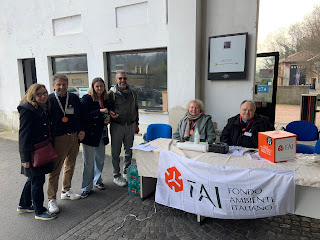The days I spent this weekend volunteering with FAI, the Italian Environment Fund, led me to think about this phenomenon of cultural volunteering. Interestingly, not only was I very enthusiastic after participating in this initiative, but all the volunteers wrote in the group how happy they were to participate.
This morning, I read an article published in the USA that talked about the running trend, of meetings of people who run all dressed in the same brand's products and thus ultimately forming brand clubs throughout the country and not unions for interests (running, precisely).
After all this, it occurred to me that before the Second World War in Germany, there were several books written that mentioned this social phenomenon. In this post, I want to break it down a little.
Cultural volunteering involves individuals contributing their time and skills to support cultural initiatives, events, or organizations within their community. This type of volunteering often focuses on promoting and preserving cultural heritage, fostering cultural exchange, and celebrating diversity.
The connection of like-minded individuals
who may not find immediate support or understanding in their immediate surroundings can be a powerful and transformative experience. Here are some key points to consider in this connection:
- Like-minded individuals typically share similar values, beliefs, and interests that may not be widely understood or appreciated in their immediate surroundings. Finding others who resonate with their perspectives can create a sense of validation and belonging, reinforcing their sense of identity and purpose.
- Connecting with like-minded individuals who share similar passions or goals can be empowering and validating. It can provide a sense of reassurance that one is not alone in their thoughts or experiences, boosting confidence and motivation to pursue their interests or causes.
- Building connections with like-minded individuals enables the exchange of ideas, knowledge, and support. This exchange can lead to collaboration, creativity, and personal growth as individuals learn from each other's experiences and perspectives.
- The connection of like-minded individuals who may not find immediate support in their surroundings can lead to the creation of supportive communities or networks. These communities offer a safe space for individuals to express themselves, seek advice, and collaborate on projects or initiatives that align with their shared interests.
- While the connection of like-minded individuals can be rewarding, it may also present challenges, such as facing criticism or opposition from those who do not share their views. However, these challenges can lead to personal growth, resilience, and a deeper understanding of one's beliefs and values.
The connection between cultural volunteering and sustainability ideas lies in their shared emphasis on preserving and promoting valuable resources for the benefit of present and future generations.
Cultural volunteering plays a crucial role in preserving and promoting cultural heritage, traditions, and practices that are at risk of being lost. By actively participating in cultural initiatives and events, volunteers help ensure the sustainability of these cultural assets for future generations.
This work contributes to the promotion of cultural diversity by creating opportunities for individuals from different backgrounds to come together, share experiences, and celebrate their unique traditions. It fosters a sense of unity and understanding, belonging, and connection to one's cultural heritage can strengthen community ties, and contribute to the overall well-being and sustainability of the community.
All the initiatives also incorporate sustainability practices, such as promoting eco-friendly behaviors, supporting local artisans and craftsmen, or organizing events with minimal environmental impact.
Lessons about social dynamics
Associations often focus on preserving and promoting cultural heritage, traditions, and practices. By actively participating, individuals contribute to the preservation of their cultural identity and heritage.




